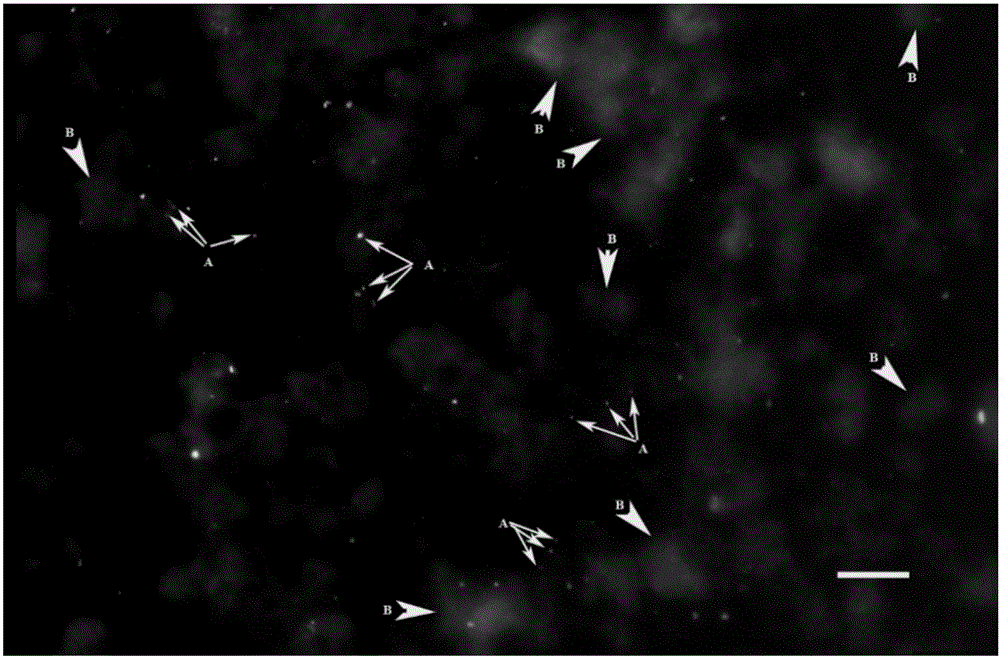Method for detecting starch degrading microorganisms in tobacco leaf
A starch degradation and microbial technology, applied in the field of microbial detection, can solve the problems of inability to form a complete and unified tobacco leaf fermentation technology, lack of in-situ information of starch degrading bacteria groups, and inability of fermentation conditions to be suitable for action conditions, and achieve accurate experimental results and cost. Low, the effect of improving the quality of taste absorption
- Summary
- Abstract
- Description
- Claims
- Application Information
AI Technical Summary
Problems solved by technology
Method used
Image
Examples
Embodiment 1
[0037] Embodiment one: a method for detecting starch-degrading microorganisms in tobacco leaves, the steps are as follows:
[0038] Sample collection: Wear sterile gloves and use a disposable sterile collection bag to randomly collect 1kg of tobacco leaf samples during the roasting or aging process, store them at a constant temperature of 37°C, and send them to the laboratory for sample processing within 20 minutes;
[0039] Sample processing: In the laboratory, first disinfect the scissors with 70% alcohol, and under sterile conditions, cut the tobacco leaf sample into 1-4cm with sterilized scissors 2 Small pieces, and carefully remove useless tissues such as stems and veins of tobacco leaves;
[0040] Diluted samples: under sterile conditions, weigh 30g of fresh crushed leaf samples in a sterile 50ml beaker, add 300ml of sample treatment reagent A, and mix evenly with the crushed leaf samples;
[0041] Cell separation: Pour the mixed liquid into a Philips (PHILIPS) househol...
Embodiment 2
[0051] Embodiment two: a method for detecting starch-degrading microorganisms in tobacco leaves, the steps are as follows:
[0052] Sample collection: Wear sterile gloves and use a disposable sterile collection bag to randomly collect 1kg of tobacco leaf samples during the roasting or aging process, store them at a constant temperature of 30°C, and send them to the laboratory for sample processing within 20 minutes;
[0053] Sample processing: In the laboratory, first disinfect the scissors with 70% alcohol, and under sterile conditions, cut the tobacco leaf sample into 1-4cm with sterilized scissors 2 Small pieces, and carefully remove useless tissues such as stems and veins of tobacco leaves;
[0054] Diluted sample: under sterile conditions, weigh 30g of fresh crushed leaf sample in a sterile 50ml beaker, add 600ml of sample treatment reagent A, and mix evenly with the crushed leaf sample;
[0055] Cell separation: Pour the mixed liquid into a Philips (PHILIPS) household b...
Embodiment 3
[0065] Embodiment three: a method for detecting starch-degrading microorganisms in tobacco leaves, the steps are as follows:
[0066] Sample collection: Wear sterile gloves and use a disposable sterile collection bag to randomly collect 1kg of tobacco leaf samples during the roasting or aging process, store them at a constant temperature of 25°C, and send them to the laboratory for sample processing within 20 minutes;
[0067] Sample processing: In the laboratory, first disinfect the scissors with 70% alcohol, and under sterile conditions, cut the tobacco leaf sample into 1-4cm with sterilized scissors 2 Small pieces, and carefully remove useless tissues such as stems and veins of tobacco leaves;
[0068] Diluted sample: under sterile conditions, weigh 50g of fresh crushed leaf sample in a sterile 50ml beaker, add 1000ml of sample treatment reagent A, and mix evenly with the crushed leaf sample;
[0069] Cell separation: Pour the mixed liquid into Philips (PHILIPS) household ...
PUM
 Login to View More
Login to View More Abstract
Description
Claims
Application Information
 Login to View More
Login to View More - R&D Engineer
- R&D Manager
- IP Professional
- Industry Leading Data Capabilities
- Powerful AI technology
- Patent DNA Extraction
Browse by: Latest US Patents, China's latest patents, Technical Efficacy Thesaurus, Application Domain, Technology Topic, Popular Technical Reports.
© 2024 PatSnap. All rights reserved.Legal|Privacy policy|Modern Slavery Act Transparency Statement|Sitemap|About US| Contact US: help@patsnap.com









